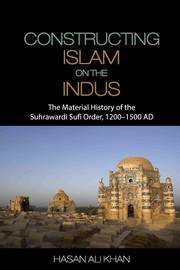Book contents
- Frontmatter
- Dedication
- Contents
- List of Figures
- Foreword
- Preface
- Acknowledgements
- Introduction
- 1 The Suhrawardi Order
- 2 Shams
- 3 The Suhrawardi Order in Uch
- 4 The Wilayat of 'Ali in Twelver Shi'ism, Sufism and the Religion of the Medieval Isma'ilis
- 5 Multan
- 6 The Da'wa and Suhrawardi Monuments at Uch
- Conclusion
- Glossary
- Notes on Referencing
- Bibliography
- Interviews and Fieldwork
- Appendices
- Index
5 - Multan
Published online by Cambridge University Press: 05 September 2016
- Frontmatter
- Dedication
- Contents
- List of Figures
- Foreword
- Preface
- Acknowledgements
- Introduction
- 1 The Suhrawardi Order
- 2 Shams
- 3 The Suhrawardi Order in Uch
- 4 The Wilayat of 'Ali in Twelver Shi'ism, Sufism and the Religion of the Medieval Isma'ilis
- 5 Multan
- 6 The Da'wa and Suhrawardi Monuments at Uch
- Conclusion
- Glossary
- Notes on Referencing
- Bibliography
- Interviews and Fieldwork
- Appendices
- Index
Summary
Entrance and axiality in orthodox Islamic burial: The qibla (Mecca) direction
This chapter and the one after it deal specifically with Suhrawardi architecture, which reflects the order's secret belief system. The two cover the major monuments left behind by the order in Multan and Uch, in the backdrop of a brief introduction to the order's notable Isma'ili contemporaries (in chapter 6). The common shrine archetype discovered for Pir Shams, his descendants, and their Suhrawardi contemporaries, exhibits certain architectural traits that contrast starkly with traditional Islamic monuments from the same era. For the greater part, this difference is in terms of the axial arrangement of the building plans and the various entrances, which are highly unorthodox. To explain the difference with reference to the conventional Islamic model, this chapter will briefly delve into established theses on orthodox Islamic burial. The subject of axiality in (traditional) Islamic burial was researched by the late Delbert Highlands, who was this author's professor when he was a student of architecture.
Highlands' research deduces the conscious incorporation of the orthodox Islamic burial axis, which is based on the Mecca direction, into the orthodox Muslim mindset, which subsequently makes its way into monument (mosque) design. Highlands observes this phenomenon in orthodox Islamic buildings as, a) always facing Mecca upon entrance to a burial chamber or a mosque, which represents the centrality of Mecca in Islam, and b) facing the exact opposite direction of Mecca while leaving the monument, which signifies the expansion of Islam as emanating from Mecca and the mosque itself, to eventually take over the whole world. In Saudi Arabia, this emphasis has recently reached new heights of literalism, where Muslims always enter the mosque from an entrance located on the right hand side of the Mecca facing facade, and leave from an exit located on the left hand side of the same facade. Even if there are secondary entrances, as is the case in large modern mosques designed to accommodate multitudes of people, the central emphasis is always on the Mecca direction.
To substantiate his thesis Highlands compared the Mecca axiality of Islamic buildings with the inverse signification of Jewish synagogues and with the Jewish mindset in general.
- Type
- Chapter
- Information
- Constructing Islam on the IndusThe Material History of the Suhrawardi Sufi Order, 1200–1500 AD, pp. 169 - 198Publisher: Cambridge University PressPrint publication year: 2015



